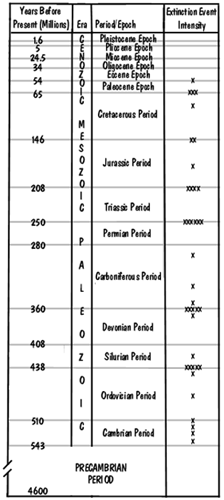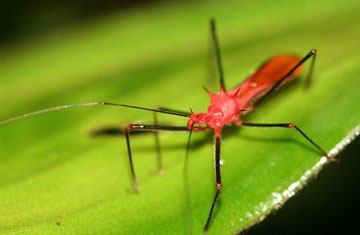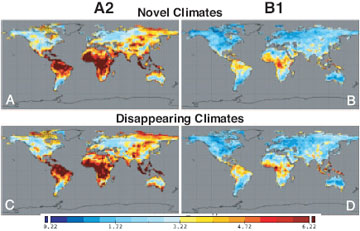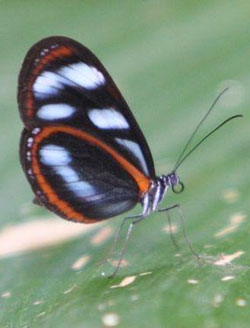Impact of global warming on extinction debated
Extinction is a hotly debated, but poorly understood topic in science. The same goes for climate change. When scientists try to forecast the impact of global change on future biodiversity levels, the results are contentious, to say the least.
While some argue that species have managed to survive worse climate change in the past and that current threats to biodiversity are overstated, many biologists say the impacts of climate change and resulting shifts in rainfall, temperature, sea levels, ecosystem composition, and food availability will have significant effects on global species richness.
Lessons from historic extinctions
There is little doubt that climate has played a critical role in past fluctuations of biodiversity levels. Among the five recognized mass extinction events — the Ordovician, the Devonian, the Permian, the Triassic and the Cretaceous — at least four are believed to have some correlation to climate change.
Peter Ward, a paleontologist at the University of Washington in Seattle, says there is evidence that most mass extinctions were caused by gradual climate change. Specifically he cites the Triassic and Permian extinctions of 200 million and 251 million years ago, respectively.
 Historic mass extinctions |
“The Triassic event isn’t something that happened overnight,” said Ward, noting that carbon dioxide levels in the atmosphere then were up to 100 times what they are today.
In the case of the Permian, rising temperatures may have caused the greatest mass extinction on record, according to a study published in the September 2005 issue of Geology. Global warming, which may have produced temperatures 10 to 30 degrees Celsius (18-54 degrees F) higher than today, is believed to have wiped out 95% of life forms in the world’s oceans and almost 75% of terrestrial species.
While climate change has caused species extinction, it has also led to the birth of new species, including mankind.
During the Paleocene-Eocene Thermal Maximum (PETM), a period 55 million years ago marked by a rapid rise in greenhouse gases that heated Earth by roughly 9° F (5° C) in less than 10,000 years, climate warming caused widespread changes, including mass extinction in the world’s oceans from acidification and shifts of plant communities due to changes in rainfall. The era helped set the stage for the “Age of Mammals,” which included the first appearance of modern primates.
Later periods of climate change in Africa may have created conditions that lef to the evolution of humans. Dr Mark Maslin, Senior Lecturer in Geography at University College London, agues that climate variation over the last 2.7 million years played a crucial part in enhancing human development. His work suggests that humans evolved during short periods of great environmental change — when dry periods were punctuated by large rapidly appearing and disappearing lakes. It was these rapid changes in water sources that forced primitive hominid communities to rapidly change and adapt
“These temporary humid periods would have imposed huge impacts on early humans,” he stated at the 2005 Annual Conference of the Royal Geographical Society in London. “Our research provides strong support for theories in which early human species evolved and spread out in response to a rapidly changing environment.”
Climate change-induced extinction breeds biodiversity, but with a delay
Despite past extinctions, on a geological time scale Earth presently has more species than ever before. However, it is important to note that while climate change has given rise to new species following mass extinction, the recovery time is measured in the millions of years, whereas humans have only been around for less than 200,000 years. Past extinction teaches us that biodiversity takes a long time to recover and species loss in coming years will not be replaced on any meaningful time scale.
 Photo by Brodie Ferguson. |
Most biologists agree that we are presently in the midst of a sixth great extinction event, one where species loss is outpacing species birth. In a paper published last year in the Annual Review of Ecology, Evolution, and Systematics, Camille Parmesan, a biologist from the University of Texas at Austin, argued that current global warming has already caused extinctions in the world’s most sensitive habitats and will continue to cause more species to go extinct over the next 50 to 100 years. Parmesan’s work shows that while some species—especially those with short generation times like insects—are evolving in response to climate change, they are not evolving in ways that could prevent extinction. Overall species evolution is not making up for species disappearance.
Current extinctions
To date, the most comprehensive forecast for the impact of climate change on global biodiversity was made in two 2004 papers published in Nature by Chris Thomas and colleagues. Analyzing the distributions of 1103 species of animals and plants from various parts of the world, the authors showed that 15-37 percent are likely to go extinct based on the best projections of future climate change.
“We matched up the current geographical distribution of each of these 1103 species with the climatic conditions in these areas, and then asked “how large an area of this type of climate will exist in 2050, and where might it be?” Dr. Thomas, a biologist from the University of York, explained to mongabay.com via email. “In many cases, the climate currently occupied by a species was expected to disappear entirely; in other cases, there was no geographic overlap between where the species currently occurs and where the climatic conditions will remain suitable – the species would have to move or potentially face extinction.”
Dr. Thomas says that the uncertainty association with climate change projections make biodiversity estimates tricky, but that their projections suggest that climate change could rival human-caused habitat loss as the leading driver of species extinction.
“Using a variety of climate scenarios, assumptions and methods of analysis, we estimated that somewhere between 5% and 50% of the species we analyzed are at risk of extinction, with the central range of estimates falling between 15% and 37%. This is on the basis of warming projected until 2050, so the year 2100 risks of extinction from climate change are likely to lie in the upper half of this range (or above),” he explained. “Our estimates of potential extinction were preliminary values intended to define the order of magnitude of the problem. We found that the extinction risks from climate change are probably similar to those from habitat loss, and conceivably even greater in some regions.”
Dr. Thomas cautions that not all the species “committed to extinction” will disappear by 2050 due to the inherent lag time of extinction.
“When the climate becomes unsuitable for the long-term survival of a species, it does not mean that it will die out immediately. For species with long-lived individuals, in particular, it may be many decades or even centuries before the last individuals die out. So, these are the numbers of species that may be declining towards extinction from 2050 onwards, not the numbers that will have died out by that date.”
How does climate change affect biodiversity?
Climate change can affect species in myriad ways including the expansion, contraction, and “migration” of habitat; increased incidence of disease and invasive species; changes in temperature, precipitation, and other environmental conditions; shifts in food availability; and failure of ecological relationships with other species — for example the loss of critical pollinators or mutualistic nutrient fixers. In the past some species may have escaped extinction by “migrating” north or southward in response to climate change. Today humans have made it a lot tougher by fragmenting, converting, and destroying habitats and potential migration corridors.
 Climate change will increase extinction risk, especially in the tropics Many of the world’s local climates could be radically changed if global warming trends continue, reports a new study published in the early online edition of the journal Proceedings of the National Academy of Sciences. The authors warn that current climates may shift and disappear, increasing the risk of biodiversity extinction and other ecological changes. |
Peter Raven, director of the Missouri Botanical Garden and a renowned expert on biodiversity, says that climate change will also make conservation efforts more difficult.
“As the climate changes, protected areas will not be able to shift due to surrounding urban areas and agricultural zones,” he told mongabay.com via telephone. “This makes them all the more susceptible to the impact of climate change, whether it is rising sea levels, a dip in precipitation levels, or warmer temperatures.”
“Habitat loss will interact with climate change too,” added Dr. Thomas. “It is hard enough to conserve enough land to protect the world’s biodiversity if it stays still – how much harder if it is moving around, as species shift their distributions into new areas where the climate becomes suitable for them. One needs to protect where species are now, where they will have to get to in future, and land in between that they must traverse on the way. Thus, the first response to maintain biodiversity in the context of climate change is to renew efforts to protect large areas of natural and semi-natural habitats, particularly in mountain ranges and other environmentally diverse regions – where species may be able to survive by moving relatively short distances from lower to higher elevations, from drier to moister soils (and vice versa), and so on.”
If so many species are expected to die out, then where are all the extinctions?
Earth’s biodiversity is still poorly known. Dr. Raven estimates that less than one-sixth of species have even been named, let alone assessed for their risk to climate change. As such, most extinction will occur among species that are small and poorly known. Further, species extinction is expected to accelerate significantly around mid-century should climate forecasts prove accurate, says Dr. Thomas.
 Photo by Rhett A. Butler. |
“We expect to see most extinction occurring from 2050 onwards, not yet,” he said. “But there is increasing evidence that species are declining at the low altitude and low latitude edges of their geographic ranges. And last year, Alan Pounds and colleagues published a paper indicating that over 1% of all of the world’s amphibian species (the harlequin frogs) have succumbed to climate-triggered outbreaks of a fungal skin pathogen. This is both sooner that I expected, and worse than I feared.”
Dr. Thomas is referring to the study which found that almost two-thirds of the 110 known harlequin Atelopus frog species of Central and South America went extinct in the 1980s and 1990s. The leading culprit for the demise was a type of chytrid fungus (Batrachochytrium dendrobatidis), an infectious skin disease. The researchers discovered strong correlations between changes in climate and the last known sightings of the frogs. According to the scientists, the Earth’s rising temperatures enhance cloud cover on tropical mountains, leading to cooler days and warmer nights, both of which favor the chytrid fungus which grows and reproduces best at temperatures between 63 to 77 degrees Fahrenheit (17 to 25 degrees Celsius).
“The harlequin frog extinctions represent an important reminder. None of the threats affecting the world’s biodiversity act in isolation. Climate change helped trigger epidemics of an emerging disease, and it was the combined forces of these two threats that was so damaging to the harlequin frogs.”
These brightly colored frogs may just be the proverbial “canary in the coal mine”: an increasing number of studies suggest that climate change could well put a wide variety of plants and animals at risk of extinction.
Beyond frogs: lemurs, birds, and coral reefs
|
RELATED ARTICLES An Interview with Peter Raven, director of the Missouri Botanical Garden: |
|||
Patricia Wright, one of the world’s foremost lemur experts, found that even small shifts in rainfall patterns can drastically affect lemur population. “A slight change in climate, even in the rainforest where we assume there is plenty of water, can impact infant survival for lemurs,” she said following the publication of a PNAS paper in 2005 that showed how even subtle changes in climate directly result in lower reproductive success in lemurs. “I was shocked to see the effect of rainfall decreases of such small magnitude on the survival of infant sifakas. The implications are huge in a world full of endangered species.” She says that deforestation and habitat fragmentation will only worsen the threat.
Similarly, climate modeling of the tropical forests of Northern South America, Dr. Paul A. T. Higgins expects a regional decline in biodiversity due to lower levels of rainfall. He says habitat destruction will make it more difficult for species to persist in shifting forests.
Meanwhile, research on birds indicated that up to 72 percent of bird species in northeastern Australia and more than a third in Europe could go extinct due to global warming. The WWF report, which reviewed more than 200 scientific articles on birds found that species most at risk included migratory, mountain, island, wetland, Arctic, Antarctic and seabirds. Last year, Britain’s environmental protection agency (DEFRA) warned that climate change will disrupt breeding, hamper migrations, and increase disease transmission in migratory birds and animals.
Finally, a series of studies published over the past few years have expressed dire concern for coral reefs. Among the most alarming was one by WWF and the Queensland government that said Australia’s Great Barrier Reef could lose 95 percent of its living coral by 2050 should ocean temperatures increase by the 1.5 degrees Celsius projected by climate scientists. Ocean acidification, resulting from higher concentrations of dissolved carbon dioxide, is a further threat to corals and plankton that form the basis of the marine food chain.
Reducing uncertainty and preventing doomsday scenarios
Though these studies are dire, they are still far from certain. Dr. Thomas says that while more research is needed to better understand the risks posed by changing climate, we need to start taking steps to address the root causes of the problem.
“Most subsequent research on extinction threats from climate change have also put the risks of extinction in the same ball park. To hone these estimates much more is going to require far more detailed work on each species in turn – the work to date is sufficient to say that climate change is likely to be a major cause of extinction, but we cannot yet specify exactly which species will survive or perish.”
“Given that approximately double the level of extinction is predicted for higher-emissions scenarios of warming, compared to lower-emissions scenarios, minimizing the amount of warming that actually takes place is the top priority.”
Dr. Ward agrees. Referring to prehistoric extinction events triggered by mass volcanism, he said, “We are heading down the same road, but we’ve traded volcanoes as the agents of destruction for SUVs.”
Dr. Raven says now the time to act.
“People are getting more cognizant of climate change as an important factor. Climate warming not only ties directly into biodiversity preservation, but it makes people aware of the problem of the loss of global biodiversity,” he said. “Now is the best opportunity we have to take action. The longer we wait, the fewer choices we have and the more we lose.”